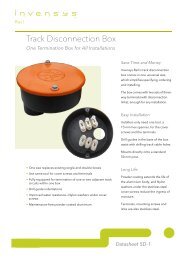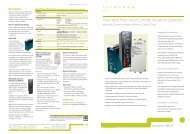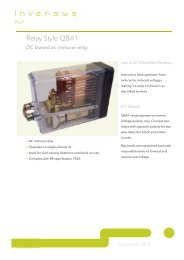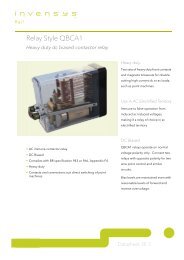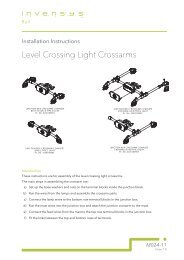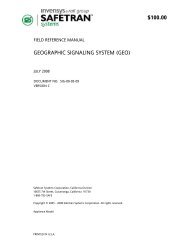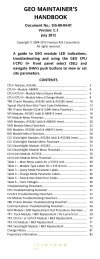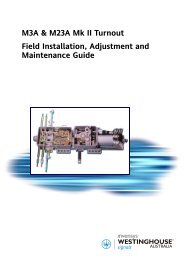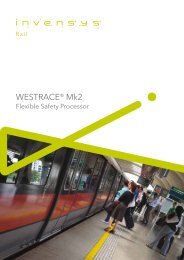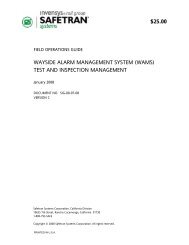Total Cost of Ownership of Rail Signalling Systems ... - Invensys Rail
Total Cost of Ownership of Rail Signalling Systems ... - Invensys Rail
Total Cost of Ownership of Rail Signalling Systems ... - Invensys Rail
You also want an ePaper? Increase the reach of your titles
YUMPU automatically turns print PDFs into web optimized ePapers that Google loves.
<strong>Total</strong> <strong>Cost</strong> <strong>of</strong> <strong>Ownership</strong> <strong>of</strong> <strong>Rail</strong> <strong>Signalling</strong> <strong>Systems</strong> <strong>Total</strong> <strong>Cost</strong> <strong>of</strong> <strong>Ownership</strong> <strong>of</strong> <strong>Rail</strong> <strong>Signalling</strong> <strong>Systems</strong><br />
20<br />
Finding 4: Ideas big<br />
and small can reduce TCO<br />
In our meetings with operators,<br />
we met with representatives<br />
from various departments –<br />
engineering, procurement,<br />
design, performance, strategy<br />
& planning. Nearly all <strong>of</strong> them<br />
had ideas or examples for<br />
reducing TCO. This is the next<br />
logical step in the process<br />
once the distribution <strong>of</strong> costs<br />
across life stages and cost<br />
drivers are understood. The<br />
ideas ranged from simple ways<br />
to incrementally reduce failure<br />
rates, others required material<br />
capital investment.<br />
“ A further step to<br />
increase effi ciency and<br />
consistency would be<br />
to link maintenance<br />
regimes to components<br />
in the asset register ”<br />
We present a selection <strong>of</strong> the ideas for which<br />
there was existing evidence or where operators<br />
anticipated material savings to TCO. They affect<br />
different life stages and the onus <strong>of</strong> development<br />
or initiative is biased to either the operator or<br />
the signalling vendor.<br />
i. Modular equipment. Off-site assembly and<br />
testing <strong>of</strong> discrete signalling modules enables<br />
a more effi cient and robust approach to system<br />
testing. It also requires less time onsite thereby<br />
reducing disruption to the network and testing<br />
to be completed with fewer possessions (which<br />
is expensive as most <strong>of</strong> our operators were<br />
capacity constrained)<br />
ii. Handheld technology to de-skill/ improve<br />
quality <strong>of</strong> installation. Use <strong>of</strong> mobile handheld<br />
technology to run testing and commissioning<br />
scripts/ routines allows elements <strong>of</strong> the testing<br />
process to be de-skilled which in turn reduces<br />
reliance on scarce engineering resource and<br />
allows a more methodical and robust approach<br />
to installation. The latter point was particularly<br />
stressed by an operator who conceded that the<br />
quality <strong>of</strong> installation was one <strong>of</strong> the biggest<br />
sources <strong>of</strong> equipment failure<br />
iii. In situ component reliability shared with<br />
equipment vendor. There was a surprising lack<br />
<strong>of</strong> information sharing between operator and<br />
signalling vendor, at best this was done in an<br />
ad hoc fashion. Where the feedback loop was<br />
well-established, unsurprisingly there was better<br />
product performance. This was particularly<br />
important as a high proportion <strong>of</strong> failures tended<br />
to be traced to a small number <strong>of</strong> components<br />
that repeated failed<br />
iv. Condition-Based Maintenance (CBM).<br />
Early detection <strong>of</strong> potential component failure<br />
(components reporting issues themselves) allows<br />
maintenance resource to be prioritised by need<br />
rather than routine and failures to be avoided.<br />
There’s a less capital intensive approach to CBM<br />
that compares usage data against statistical data<br />
to predict failures, this may appeal to operators<br />
who have large networks that make the retr<strong>of</strong>i<br />
tting <strong>of</strong> sensors an unwieldy and expensive task<br />
v. Planned maintenance regimes that take<br />
into account the proximity <strong>of</strong> assets allow<br />
multiple components to be inspected during<br />
the same visit – this reduces travel time<br />
which can be equivalent to the time spent<br />
on an inspection. A further step to increase<br />
effi ciency and consistency would be to link<br />
maintenance regimes to components in the asset<br />
register which could in turn drive a workload<br />
management system. Engineers could then<br />
have their scheduled tasks downloaded to their<br />
handheld device and update the asset history on<br />
completion <strong>of</strong> the inspection.<br />
Idea Summary<br />
Figure 12<br />
Idea Life stage affected <strong>Cost</strong> Benefits<br />
i. Modular equipment Testing &<br />
commissioning<br />
ii. Handheld<br />
technology for<br />
installation<br />
iii. In situ component<br />
reliability<br />
iv. Condition-based<br />
maintenance<br />
v. Planned maintenance<br />
regimes<br />
vi. Handheld<br />
technology as<br />
a training tool<br />
Incremental improvements<br />
Other practical ideas put forward by operators<br />
that we believe are worthy <strong>of</strong> mention for their<br />
simplicity and pragmatism:<br />
• Replacing signal lamps LED versions that last<br />
up 20 times longer than traditional bulbs. This<br />
not only reduces the maintenance burden but<br />
consumes less energy.<br />
• Rationalising signal boxes and rooms to a fewer<br />
number <strong>of</strong> control rooms. At one operator, this<br />
resulted in 300 signal boxes being reduced<br />
to control centres with significant associated<br />
cost savings.<br />
vi. Handheld technology as a training tool.<br />
The diversity <strong>of</strong> signalling equipment that needs<br />
to be maintained by an engineer presents a<br />
training challenge. Handheld-based maintenance<br />
instructions (checklists) linked to an asset register<br />
which holds the component maintenance<br />
history allows faster fault resolution; improved<br />
proportion <strong>of</strong> fi rst time fi xes; and can reduce<br />
the reliance on classroom training. Another tool<br />
is visualisation, where engineers can train in<br />
simulated 3D environments, this has been used<br />
successfully in the oil and gas industry to allow<br />
engineers to practice in real-life situations<br />
Capex • Reduced trackside testing time<br />
• Standardised building blocks<br />
• Minimise network disruption/track access<br />
Installation Capex • Script-driven procedures improves quality <strong>of</strong> installation<br />
• Unit testing can be delegated to lower skilled engineers;<br />
reduces reliance on scarce resource<br />
Maintenance Minimal • Reduced failure rates<br />
• Improved component design<br />
Maintenance Capex • Failure rate improvement; delay avoidance<br />
• Reduced maintenance effort – intervention prioritised<br />
by need rather than periodic inspections<br />
Maintenance Minimal • Improved maintenance productivity<br />
(reduction <strong>of</strong> travel time)<br />
Maintenance Capex • Faster fault resolution; improved proportion <strong>of</strong> first<br />
time fixes<br />
• Maintenance history linked to asset record<br />
• Half life extension <strong>of</strong> interlocking cards every<br />
15yrs – to prolong life and reduce frequency <strong>of</strong><br />
faults prior to full life replacement every 25 – 30 yrs.<br />
Interlocking failures are <strong>of</strong>ten complex to<br />
resolve and can therefore cause long delays,<br />
this may not be cost effective but can certainly<br />
help avoid detrimental headlines complaining<br />
<strong>of</strong> long delays.<br />
I300203_<strong>Invensys</strong>_<strong>Cost</strong>Of<strong>Ownership</strong>_WhitePaper.indd 20-21 13/04/2010 15:11<br />
21





